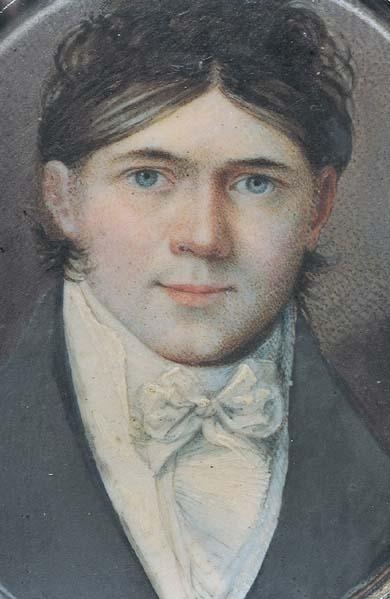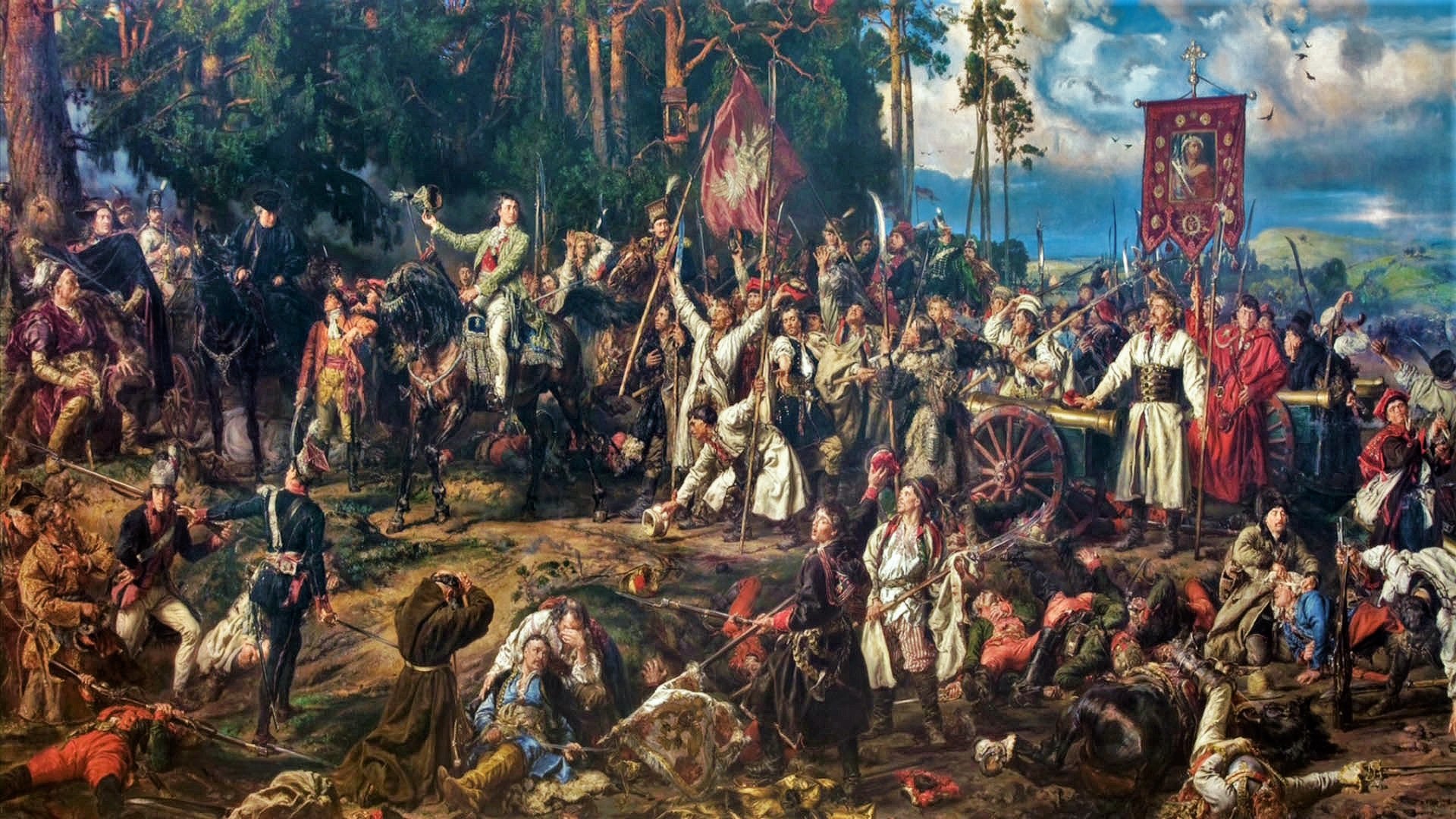|
Carl Peter Lehmann
Carl Peter Lehmann (10 October 1794, Copenhagen - 3 September 1876, Sigtuna) was a Danish-Swedish portrait painter who also worked in Norway. Biography His father was a musician with a travelling theatrical troupe and he apparently worked as a handyman, although some sources also describe him as an acrobat. His artistic talent was discovered when he painted decorations for the troupe's performances. In 1817, after marrying a dancer named Sophie Pershey, he left the troupe to set up his own painting school in Bergen and applied for citizenship there. This was granted in 1820 and he operated his school until 1826. His students there included Knud Baade and Joachim Frich. From 1819 to 1825, he concentrated on landscapes and historical scenes. His first exhibition in Sweden came in 1822. After died that same year, Lehmann took over his position as a decorative painter for Det Dramatiske Selskab. Three years later, he organized his own exhibition and promoted it by advertising ... [...More Info...] [...Related Items...] OR: [Wikipedia] [Google] [Baidu] |
Göteborgs Konstmuseum
Gothenburg Museum of Art ( sv, Göteborgs konstmuseum) is located at Götaplatsen in Gothenburg, Sweden. It claims to be the third largest art museum in Sweden by size of its collection. Collections The museum holds the world's finest collection of late 19th century Nordic art. A highlight is the lavishly decorated Fürstenberg Gallery, named after a leading Gothenburg art donor, Pontus Fürstenberg and his wife Göthilda. Among the artists showcased are P.S. Krøyer, Carl Larsson, Bruno Liljefors, Edvard Munch, and Anders Zorn. The museum also houses older and contemporary art, both Nordic and international. The collection includes, for example, Monet, Picasso and Rembrandt. The Museum has been awarded three stars in the Michelin Green Guide (Green Guide Scandinavia). Architecture The museum building was designed for the Gothenburg Exhibition (1923), Gothenburg Exhibition (''Jubileumsutställningen i Göteborg'') in 1923 by architect Sigfrid Ericson (1879-1958). The eas ... [...More Info...] [...Related Items...] OR: [Wikipedia] [Google] [Baidu] |
Swedish Painters
This is a list of notable Swedish visual artists. A * Emma Adbåge (born 1982), illustrator * Ottilia Adelborg (1855–1936), illustrator * Ulla Adlerfelt (1736–1765) *Sofia Adlersparre (1808–1862), painter * Mattias Adolfsson (born 1965), illustrator * Gösta Adrian-Nilsson GAN (1884–1965), painter * Ivan Aguéli (1869–1917), painter and writer * Märta Afzelius (1887–1961), textile artist *Sofia Ahlbom (1823–1868) *Lea Ahlborn (1829–1891), printmaker *Modhir Ahmed (born 1956), painter, printmaker *Margareta Alströmer (1763–1816), painter * Agneta Andersson (born 1958), sculptor *Christian Pontus Andersson (born 1977), sculptor *J. Tobias Anderson (born 1971) *Karin Mamma Andersson (born 1962), painter *Lena Anderson (born 1939), illustrator and children's writer *Oskar Andersson (1877–1906), cartoonist *Olof Arborelius (1842–1915), painter *Tage Åsén (born 1943), painter B *Barbro Bäckström (1939–1990), sculptor *Inge Bagge (1916–1988), sculp ... [...More Info...] [...Related Items...] OR: [Wikipedia] [Google] [Baidu] |
1876 Deaths
Events January–March * January 1 ** The Reichsbank opens in Berlin. ** The Bass Brewery Red Triangle becomes the world's first registered trademark symbol. * February 2 – The National League of Professional Base Ball Clubs is formed at a meeting in Chicago; it replaces the National Association of Professional Base Ball Players. Morgan Bulkeley of the Hartford Dark Blues is selected as the league's first president. * February 2 – Third Carlist War – Battle of Montejurra: The new commander General Fernando Primo de Rivera marches on the remaining Carlist stronghold at Estella, where he meets a force of about 1,600 men under General Carlos Calderón, at nearby Montejurra. After a courageous and costly defence, Calderón is forced to withdraw. * February 14 – Alexander Graham Bell applies for a patent for the telephone, as does Elisha Gray. * February 19 – Third Carlist War: Government troops under General Primo de Rivera drive through the ... [...More Info...] [...Related Items...] OR: [Wikipedia] [Google] [Baidu] |
1794 Births
Events January–March * January 1 – The Stibo Group is founded by Niels Lund as a printing company in Aarhus (Denmark). * January 13 – The U.S. Congress enacts a law providing for, effective May 1, 1795, a United States flag of 15 stars and 15 stripes, in recognition of the recent admission of Vermont and Kentucky as the 14th and 15th states. A subsequent act restores the number of stripes to 13, but provides for additional stars upon the admission of each additional state. * January 21 – King George III of Great Britain delivers the speech opening Parliament and recommends a continuation of Britain's war with France. * February 4 – French Revolution: The National Convention of the French First Republic abolishes slavery. * February 8 – Wreck of the Ten Sail on Grand Cayman. * February 11 – The first session of the United States Senate is open to the public. * March 4 – The Eleventh Amendment to the United States Constituti ... [...More Info...] [...Related Items...] OR: [Wikipedia] [Google] [Baidu] |
Project Runeberg
Project Runeberg ( sv, Projekt Runeberg) is a digital cultural archive initiative that publishes free electronic versions of books significant to the culture and history of the Nordic countries. Patterned after Project Gutenberg, it was founded by Lars Aronsson and colleagues at Linköping University and began archiving Nordic-language literature in December 1992. As of 2015 it had accomplished digitization to provide graphical facsimiles of old works such as the '' Nordisk familjebok'', and had accomplished, in whole or in part, the text extractions and copyediting of these as well as esteemed Latin works and English translations from Nordic authors, and sheet music and other texts of cultural interest. Nature and history Project Runeberg is a digital cultural archive initiative patterned after the English-language cultural initiative, Project Gutenberg; it was founded by Lars Aronsson and colleagues at Linköping University, especially within the university group Lysator ( ... [...More Info...] [...Related Items...] OR: [Wikipedia] [Google] [Baidu] |
Nordisk Familjebok
''Nordisk familjebok'' (, "Nordic Family Book") is a Swedish encyclopedia that was published in print from between 1876 and 1993, and that is now fully available in digital form via Project Runeberg at Linköping University. Despite their considerable age and relative obsolescence, the public domain editions of the encyclopedia remain important reference works in Finland, especially on Finnish Wikipedia. History First edition ''Nordisk familjebok'' began when Halmstad publisher hired an editor, linguist , in 1874 to publish a six-volume encyclopedia. Linder drew up a plan for the work, designed the editorial team and created a large circle of experts and literary figures, who submitted article proposals and wrote and reviewed them. Under Linder's direction, the articles were then edited to make them as formal, consistent and accurate as possible. Much attention was paid to Nordic subjects, mainly Swedish and Finnish, where sources and models were often lacking, so extensive ... [...More Info...] [...Related Items...] OR: [Wikipedia] [Google] [Baidu] |
Kunstindeks Danmark
''Weilbachs Kunstnerleksikon'' (Weilbach's Biographical Dictionary of Artists) is a Danish biographical dictionary of artists and architects. The current edition, which is also freely accessible online, contains the biographies of some 8,000 Danish artists and architects. History The first edition, ''Dansk Konstnerlexikon'' (1878), was the work of Philip Weilbach Philip Weilbach (5 August 1834, Usserød – 22 November 1900, Copenhagen) was a Danish art historian and encyclopedist. He is remembered above all for his pioneering work on the early editions of the biographical dictionary, ''Weilbachs Kunstne ... which he expanded into the two-volume ''Nyt dansk Kunstnerlexikon'' in 1897. In subsequent editions, it became the standard reference work on all notable Danish artists and architects. The third edition, under the auspices of a committee, was published in three volumes (1947–1952) and was said to provide biographical details and information on Danish artists including pa ... [...More Info...] [...Related Items...] OR: [Wikipedia] [Google] [Baidu] |
Oslo
Oslo ( , , or ; sma, Oslove) is the capital and most populous city of Norway. It constitutes both a county and a municipality. The municipality of Oslo had a population of in 2022, while the city's greater urban area had a population of in 2019, and the metropolitan area had an estimated population of in 2021. During the Viking Age the area was part of Viken. Oslo was founded as a city at the end of the Viking Age in 1040 under the name Ánslo, and established as a ''kaupstad'' or trading place in 1048 by Harald Hardrada. The city was elevated to a bishopric in 1070 and a capital under Haakon V of Norway around 1300. Personal unions with Denmark from 1397 to 1523 and again from 1536 to 1814 reduced its influence. After being destroyed by a fire in 1624, during the reign of King Christian IV, a new city was built closer to Akershus Fortress and named Christiania in honour of the king. It became a municipality ('' formannskapsdistrikt'') on 1 January 1838. The city fu ... [...More Info...] [...Related Items...] OR: [Wikipedia] [Google] [Baidu] |
Bygdøy
Bygdøy or Bygdø is a peninsula situated on the western side of Oslo, Norway. Administratively, Bygdøy belongs to the borough of Frogner; historically Bygdøy was part of Aker Municipality and became part of Oslo in 1948. Bygdøy is a popular recreation area and is among the most fashionable residential areas in Norway, where the most expensive properties in the entire country are found. Bygdøy is also the home of five national museums as well as a royal estate. Wealthy families of Christiania acquired country houses in Bygdøy during the 18th and 19th centuries; by the 19th century Bygdøy had become a favourite of the wealthy in the capital region and was exclusively settled by the wealthy and their servants. Tourism Bygdøy has parks and forests, and beaches including the Huk ordinary and nudist beach. In 1885 there were only 111 houses at Bygdøy; today most of the huge gardens are split into smaller patches of land, making Bygdøy largely a residential zone but reta ... [...More Info...] [...Related Items...] OR: [Wikipedia] [Google] [Baidu] |
Norsk Folkemuseum
Norsk Folkemuseum (Norwegian Museum of Cultural History), at Bygdøy, Oslo, Norway, is a museum of cultural history with extensive collections of artifacts from all social groups and all regions of the country. It also incorporates a large open-air museum with more than 150 buildings, relocated from towns and rural districts. The Norwegian Museum of Cultural History is situated on the Bygdøy peninsula near several other museums, including the Viking Ship Museum; the Fram Museum; the Kon-Tiki Museum; and the Norwegian Maritime Museum. History ''Norsk Folkemuseum'' was established in 1894 by librarian and historian Hans Aall (1869–1946). It acquired the core area of its present property in 1898. After having built temporary exhibition buildings and re-erected a number of rural buildings, the museum could open its gates to the public in 1901. In 1907, the collections of King Oscar II, on the neighbouring site, was incorporated into the museum. Its five relocated buildings, with ... [...More Info...] [...Related Items...] OR: [Wikipedia] [Google] [Baidu] |
Nationalmuseum
Nationalmuseum (or National Museum of Fine Arts) is the national gallery of Sweden, located on the peninsula Blasieholmen in central Stockholm. The museum's operations stretches far beyond the borders of Blasieholmen, the nationalmuseum manage the National Portrait gallery collection at Gripshom, Gustavsbergporclain museum, a handful of castle collections and the Swedish Institute in Paris (Institut Tessin). In the summer of 2018 Nationalmuseum Jamtli opened in Östersund as a way to show a part of the collection in the north of Sweden. The museum's benefactors include King Gustav III and Carl Gustaf Tessin. The museum was founded in 1792 as Kungliga Museet ("Royal Museum"). The present building was opened in 1866, when it was renamed the Nationalmuseum, and used as one of the buildings to hold the 1866 General Industrial Exposition of Stockholm. The current building, built between 1844 and 1866, was inspired by North Italian Renaissance architecture. It is the design of ... [...More Info...] [...Related Items...] OR: [Wikipedia] [Google] [Baidu] |





